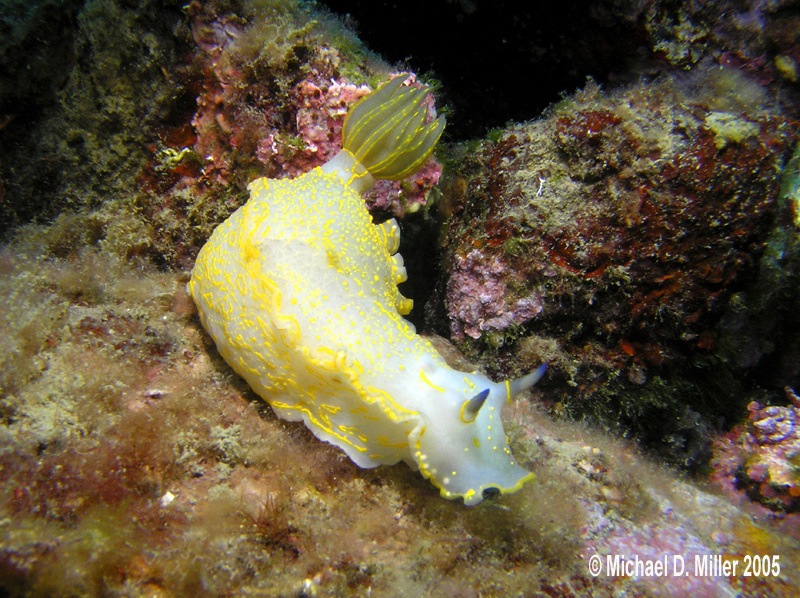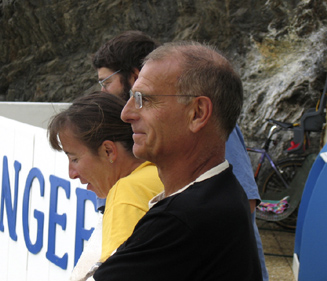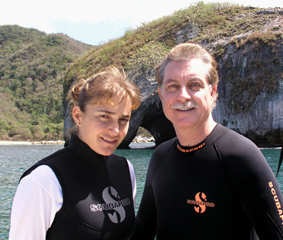 |
Hypselodoris picta picta
(Schultz, 1836) Size about 3 inchesPhoto courtesy of Webmaster
Cerbere, France
Hypselodoris picta picta (Schultz, 1836)
Hypselodoris picta is a complex of six closely related subspecies, with all but two geographically separated: Hypselodoris picta picta (Schultz, 1836); Hypselodoris picta webbi (d'Orbigny, 1839); Hypselodoris picta azorica Ortea, Valdes & Garcia-Gomez, 1996; Hypselodoris picta tema Edmunds, 1981; Hypselodoris picta verdensis Ortea, Valdes & Garcia-Gomez, 1996; and Hypselodoris picta lajensis Troncoso, Garcia & Urgorri (1998).
Because of its wide variation in color, the systematics of this species is confused even more, as it H. picta has been referred to in the literature as - Hypselodoris elegans (Cantraine, 1835); Hypselodoris webbi (d'Orbigny, 1839); Hypselodoris valenciennesi (Cantraine, 1841); Hypselodoris edenticulata (White, 1952); and Hypselodoris tema Edmunds, 1981.
Since webmaster Mike took this shot in France, we can assume it is Hypselodoris picta picta (Schultz, 1836), the original species described in 1836.
It is the largest chromodorid in the Mediterranean Sea reaching 4 inches in length. Juveniles have three lines on the dorsum, whereas in the adults the pattern is more complicated with numerous broken or entire lines. It is also characteristic of this species that two of the dorsal lines reach the rhinophoral sheaths. In adult specimens they form a yellow circle around the edge of the rhinophoral sheath and continue forward (see {{{Rudman}}}.
The gill structure is outlined with a yellow line.
Too see video of this guy, go to
Hypselodoris picta picta .
Gig Harbor, Washington
Aug, 2005
Robert Oms,Course Director at Cerbere, France

I know what you're going to ask and a reporter at Cerbere asked the same question; why did you trave all the way from San Diego, California to Cerbere, France? Well, I answered, marine sea slugs are my passion! Robert Oms, the course director, quickly interjected "our passion." And that exchange sums up the course in a nutshell! All the attendees exhibited an enthusiasm that transcended language barriers! At the onset I had several misconceptions about traveling to France and one of them was the water temperature in the Mediterrean this time of year. The water temperature on the beaches may have been fine, but the "diving" temperature was in the low sixties! So my 3mm suit proved useless and I outfitted with a 7mm suit from the local french dive operation. The course schedule consisted of two day dives followed by laboratory examination and lectures by Gerard Breton on Opisthobranchs. This allowed ten (10) dives and an optional night dive in the harbor area. The final specimen tally came in at thirty nine (39) but with everyone of them new to me. Many were in the under 10 mm range, so just about all course participants had a magnifying glass in addition to a digital camera hanging off a lanyard. Well equipped for the hunt as you can imagine! Water conditions were great with 50 ft. vizability on most days. In addition to branchs also saw a lot of Octopus and we even had a visiting Mola-Mola (Sunfish) come through one day. |
Also took a day off my Paris schedule to travel to Normandy and pay my respects to all the gallant men and women who paid the ultimate sacrifice to preserve freedom for all people around the world. My Uncle came ashore with Patton's group at this very place. Bill survived to tell parts of the story to me many years later.
So what would I have done different in planning given hindsight? I wasn't tracking the Tour de France as I should have been! Definitely should have been in Paris on July 24th to see Lance finish four minute lead or not. Could have jumped on an overnight train and made it!
In conclusion, I throughly enjoyed the course and recommend going to all you slug heads and you know who you are! The course is limited in the number of attendees so contacting Robert Oms is recommended at an early date. The course usually runs in July.
For those of you that want to take a cyberspace tour of the recent course, you can log on to a streaming slide show of the trip. Viewing will require downloading a presenter module but it is harmless representing no threat to your system although it may disabling or reconfiguring programs like Zone Alarm to permit the presentation. It would also help to be on a high speed connection!
Contact Robert at roboms@freesurf.fr
Send the Webmaster email at mdmiller@cts.com
San Diego, California
August, 2005
March 2005

Ali Hermosillo and Dave Behrens
Author:
Pacific Coast Nudibranchs
Send Dave mail at dave@seachallengers.com
|
